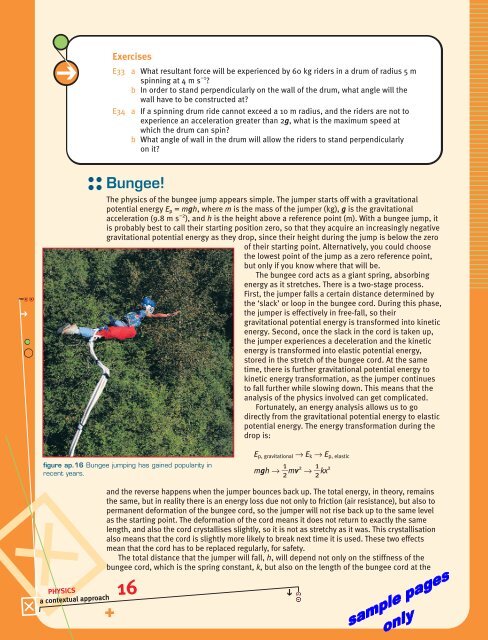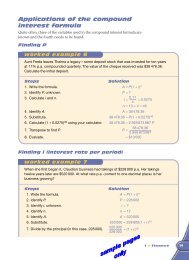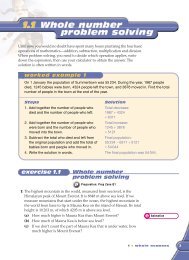Context 1: Amusement Park Physics - hi.com.au
Context 1: Amusement Park Physics - hi.com.au
Context 1: Amusement Park Physics - hi.com.au
Create successful ePaper yourself
Turn your PDF publications into a flip-book with our unique Google optimized e-Paper software.
⌧<br />
<br />
➔<br />
➔<br />
Bungee!<br />
The physics of the bungee jump appears simple. The jumper starts off with a gravitational<br />
potential energy Ep = mgh, where m is the mass of the jumper (kg), g is the gravitational<br />
acceleration (9.8 m s –2 ), and h is the height above a reference point (m). With a bungee jump, it<br />
is probably best to call their starting position zero, so that they acquire an increasingly negative<br />
gravitational potential energy as they drop, since their height during the jump is below the zero<br />
of their starting point. Alternatively, you could choose<br />
the lowest point of the jump as a zero reference point,<br />
but only if you know where that will be.<br />
The bungee cord acts as a giant spring, absorbing<br />
energy as it stretches. There is a two-stage process.<br />
First, the jumper falls a certain distance determined by<br />
the ‘slack’ or loop in the bungee cord. During t<strong>hi</strong>s phase,<br />
the jumper is effectively in free-fall, so their<br />
gravitational potential energy is transformed into kinetic<br />
energy. Second, once the slack in the cord is taken up,<br />
the jumper experiences a deceleration and the kinetic<br />
energy is transformed into elastic potential energy,<br />
stored in the stretch of the bungee cord. At the same<br />
time, there is further gravitational potential energy to<br />
kinetic energy transformation, as the jumper continues<br />
to fall further w<strong>hi</strong>le slowing down. T<strong>hi</strong>s means that the<br />
analysis of the physics involved can get <strong>com</strong>plicated.<br />
Fortunately, an energy analysis allows us to go<br />
directly from the gravitational potential energy to elastic<br />
potential energy. The energy transformation during the<br />
drop is:<br />
✚<br />
Exercises<br />
E33 a What resultant force will be experienced by 60 kg riders in a drum of radius 5 m<br />
spinning at 4 m s –1 ?<br />
b In order to stand perpendicularly on the wall of the drum, what angle will the<br />
wall have to be constructed at?<br />
E34 a If a spinning drum ride cannot exceed a 10 m radius, and the riders are not to<br />
experience an acceleration greater than 2g, what is the maximum speed at<br />
w<strong>hi</strong>ch the drum can spin?<br />
b What angle of wall in the drum will allow the riders to stand perpendicularly<br />
on it?<br />
figure ap.16 Bungee jumping has gained popularity in<br />
recent years.<br />
PHYSICS<br />
a contextual approach<br />
Ep, gravitational → Ek → Ep, elastic<br />
1 2 1 2<br />
mgh → mv → 2 kx<br />
2<br />
and the reverse happens when the jumper bounces back up. The total energy, in theory, remains<br />
the same, but in reality there is an energy loss due not only to friction (air resistance), but also to<br />
permanent deformation of the bungee cord, so the jumper will not rise back up to the same level<br />
as the starting point. The deformation of the cord means it does not return to exactly the same<br />
length, and also the cord crystallises slightly, so it is not as stretchy as it was. T<strong>hi</strong>s crystallisation<br />
also means that the cord is slightly more likely to break next time it is used. These two effects<br />
mean that the cord has to be replaced regularly, for safety.<br />
The total distance that the jumper will fall, h, will depend not only on the stiffness of the<br />
bungee cord, w<strong>hi</strong>ch is the spring constant, k, but also on the length of the bungee cord at the<br />
16<br />
<br />
➔

















